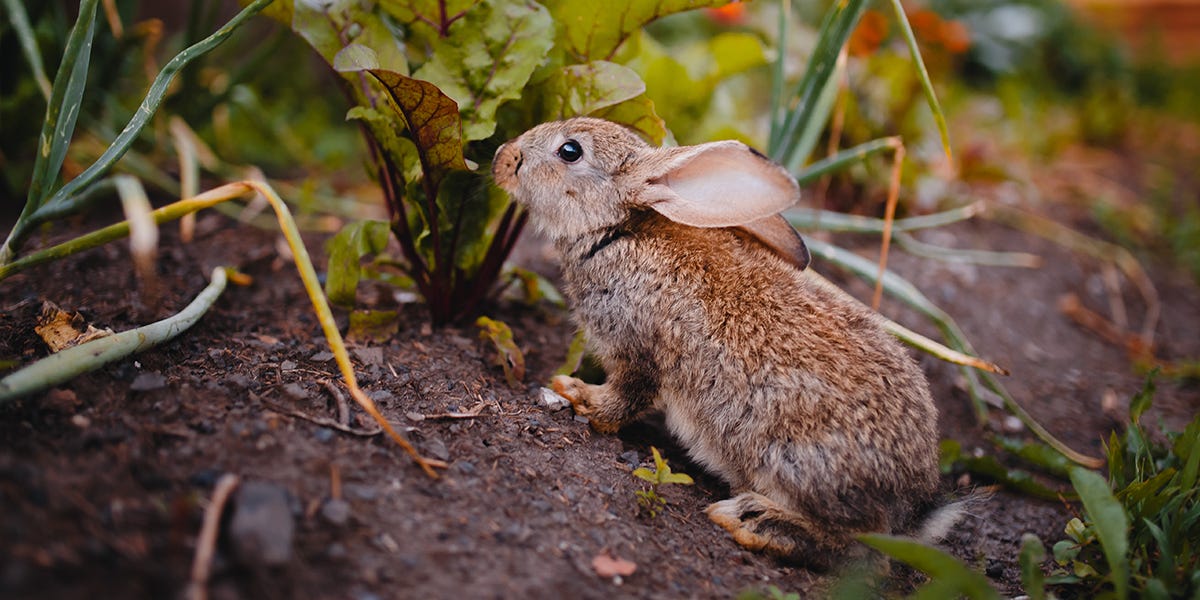How to Keep Rabbits Away From Your Garden
Most Effective Products
How to Keep Rabbits Away From Your Garden
This article contains information and suggestions to help decrease the presence of rabbits within your garden. By following these methods and using the recommended products, you can completely get control of your rabbit problem. While following these guidelines, Local and State Laws are still present and must be followed. It is recommended for the homeowner to visit their local animal control office or state website to visit proper rules and regulations associated with the control of rabbits.
The more rainfall and care going into your garden leads to more of a food supply for pesky critters, like rabbits. If their food is abundant these furry pests are more likely to breed and visit these areas. Rabbits use grass and weeds surrounding your garden to create nests and feed on flowers or vegetables within your garden.
Rabbits eat just about any type of plant materials from ornamentals, small shrubs and bushes, or vegetables. In addition to feeding on foliage these pests also dig into the soil and urinate in or around your garden, causing brown patches of grass.
Rather than watching your garden go to waste, read on to learn how to eliminate rabbits in your gardens through the recommended products and techniques.
Signs of Rabbits in Garden

Although rabbits are a common garden pests it is important to verify they are the real culprits behind your destroyed garden. Careless identification can risk you purchasing unneeded product materials and be a waste of your time. Here are some giveaways you should look for to confirm the presence of these rabbits.
- Small piles of circular, pea-sized balls. These pellets will be black or brown in coloration.
- Rabbits often leave burrows or tunnels that are 10-15 cm in diameter with an inward slope at a shallow angle. The entrance of these tunnels will be compacted with dirt and the walls will be smooth.
- Missing seedlings or shoots of young plants. Clean angled cut vegetation and leaves, which looks as if it was done with a pair of scissors.
- Tufts of rabbit fur in turfgrass adjacent to garden, or underneath shrubbery and tree branches.
- Patches of brown or yellow colored grass caused by rabbit urine.
- Though more common in the winter, if there is not enough vegetation then rabbits will clip twigs and gnaw the bark of wood plants.
What Keeps Rabbits Out of Your Garden
Rabbits tend to breed in winter and give birth to their kittens in the early spring. Litter sizes ranges between 3 to 5 kittens, another name for young rabbits. Control methods are best to implement in the early spring when adults rabbits are actively foraging for food and nesting sites.
These animals prefer bushy or overgrown areas that are near open spaces with turfgrass, landscape plants, woody plants, broad-leaved plants, vegetables, and other forb-like plants. Fence rows with plenty of weeds and other tall plants and homes with landscaped areas, sheds, and other similar structures provides plenty of cover for rabbits.
Each of the steps listed has its advantages and disadvantages, so a combination of methods will be most effective for rabbits. Before you begin with control, you will need to wear the proper personal protective equipment (PPE).
Step 1: Eliminate Hiding Places

Rabbits are opportunistic feeders. They prefer a variety of foods, treating gardens and landscape areas as a open buffet. These animals do not like to hang around open spaces for long and prefer to easily escape into dense, vegetation like shrubs or underneath structures like sheds.
Keep plenty of open spaces around your garden by mowing away thickets and tall grass when it reaches a height greater than 3 inches. Dense shrub and tree branches hanging too low to the ground can be pruned so rabbits cannot hide there.
Relocate rock piles into indoor spaces to prevent rabbits from hiding in-between or underneath them. Wood piles will need to be stacked onto a metal rack to get them off the ground so this way rabbits cannot create burrows underneath them.
Step 2: Put Up Barriers

Fencing is the top choice for physical barriers against rabbits, but these animals can squeeze through small areas. For this reason, use 1 inch wire mesh or smaller to install around vegetable and flower gardens, and ornamental plants. The bottom edge of the wire must be buried 3 to 6 inches deep or more to prevent rabbits from burrowing under and away from the roots of plants to avoid damage.
Fences should be built up to at least 2 feet high to prevent rabbits from jumping over to reach garden plants. Guards or fencing around larger plants like trees and shrubs can help to prevent gnawing to the main stem or trunk. Shrubs with multiple branches should be circled with 1 inch wire mesh, but provide enough room for the branches to spread without touching the fencing.
For sheds and similar structures, make a perimeter fencing around the foundation with galvinized netting, chicken wire, or wire mesh material measuring 1 inch or less. Keep it securely in place against the shed by stapling it and cut away excessive fencing not needed.
Step 3: Use Humane Traps

Rabbits have natural predators, including owls, cats, coyotes, foxes, and snakes. To evade these predators rabbits tend to travel underneath overgrown foliage branches and other thick vegetation. Since rabbits are not too specific about their food there is little bait options available, but by laying humane traps along these frequently traveled areas these pests can be captured.
We recommend using Solutions Humane Live Animal Trap in a size medium to capture rabbits traveling to and from your garden. This single door trap is comprised of sturdy, rust resistant wire mesh and steel reinforcements, effectively trapping the rabbit without harm and escape from trapping. To increase the traps success and safety of the trapped rabbit from excessive heat, place the product in a shaded area such as underneath or in-between shrubs and trees. Place a brick or weight on top of the trap to avoid the rabbit moving it.
Once the Solutions Humane Live Animal Trap has been set in an area with high amount of rabbit activity you can then set it. To set this product, push the door lock and lift the door plate. Keep the door plate lifted while pulling the trigger arm forward to set it. You will know its set when the trigger arm's hook catches the door.
Check the traps from a safe distance at least once a day. Checking the traps frequently may dissuade rabbits from approaching the Solutions Humane Live Animal Trap.
Step 4: Repel Rabbits

Like most animals, rabbits tend to use their sense of smell to navigate your yard making them sensitive to smells. They also prefer to travel and feed during the dusk and dawn when predators and people are not as active. With that in mind, you can use a rabbit repellent like Rabbit Scram Professional. Animal Stopper Granular Repellent is a organic, granular repellent made with natural ingredients. All of which are warnings of predators to the rabbits sense of smell leading to the animal avoid treated areas without harm for up to 30 days.
Shake the product over the areas you wish to treat. Apply Animal Stopper Granular Repellent liberally to dens, tunnels, entries, and around plants that need protection. When using near edible crops, apply a perimeter application.
Preventing Rabbits in Gardens

Once rabbits have been removed from your garden, you will need to ensure these pests do not return. Listed below are some effective ways to keep rabbits out of your garden.
- To protect your garden against rabbits, install and maintain fence materials around garden, shrubs, ornamentals, small trees, and around outdoor structures like sheds.
- Remove wood and rock piles, and other yard debris. Natural plant debris like tall grass, thickets, and other overgrown areas can be mowed or pruned.
- Water vegetation with an inch of irrigation to encourage plants to grow no more than once a week. Consistent watering will help deter rabbits from settling in that area due to probability of flooding burrows. Watering early in the morning will allow enough time for irrigated areas to dry, but also potentially scare rabbits away as this is when they are most active.
- Be prepared to remove plants that rabbits consistently feed on or wrap wire mesh material around plant no larger than 1-inch.
- Allow cats and dogs to play outside occasionally to help spread their scent across property. Rabbits become fearful or distrustful of certain areas with high amount of predator scents.
- Reapply Rabbit Scram Professional as needed or every 45 days if there is on-going rabbit activity. Periods of excessive rainfall or sunlight can call for reapplication of this product.
Key Takeaways
What Attracts Rabbits to Your Garden
- Gardens provide two things that every rabbits needs which is shelter from predators and an abundant food source.
How to Get Rid of Rabbits From Garden
- To get rid of rabbits from your garden you will need to trim overgrown shrub and tree branches and mow tall grassy areas. Once vegetation is down then install physical barriers such as fencing and wiring around garden, landscape areas, small trees, shrubs, and sheds. Set Solutions Humane Live Animal Trap in-between or near dense, vegetation adjacent to garden. Apply Animal Stopper Granular Repellent around your garden plants and flower beds.
How to Prevent Rabbits From Eating Your Garden
- To discourage rabbits from eating and visiting your garden maintain a wire mesh no larger than 1-inch in spacing around your desired foliage. Continue to apply Rabbit Scram Professional every 30 to 45 days for on-going rabbit activities or where is excessive rainfall and or sunlight.











































































































































































































































































































































































































































































































































